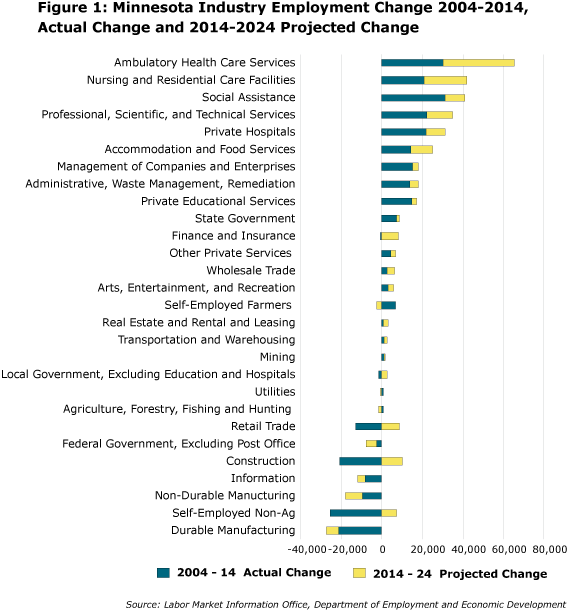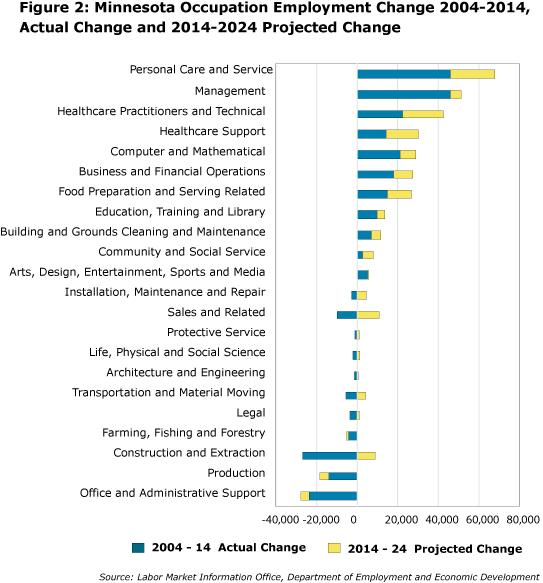
by Dave Senf
September 2016
Various forces are driving job growth in some Minnesota occupations and decline in others.
Minnesota’s ongoing shift from a goods-based to a knowledge-based service economy is evident in the occupational and industrial employment shifts that have occurred over the last decade and in the changes projected for the next decade (Figure 1 and 2).


Even though net job growth was only 111,000 between 2004 and 2014 and is projected to be only 130,000 from 2014 to 2024, plenty of changes are occurring below the surface when it comes to occupational and industrial employment in Minnesota.
Shifts in consumer tastes, evolving technology, innovations in business and management practices, changes in government funding, globalization and changes in laws are the leading forces, among many, causing declining employment in some occupations that once offered solid careers. Those same forces are creating rapid growth in other occupations that were unheard of just a decade ago.
Occupations that are heavily concentrated in shrinking industries have and will continue to see job numbers fall. Production jobs, such as print binding and finishing workers or paper goods machine setters, are declining occupations in shrinking industries.
Health-care related occupations, like registered nurses or medical assistants, on the other hand, have been and will continue to be expanding occupations.
Shifts in the occupational staffing pattern in industries with declining or flat employment can still generate job growth for some occupations. Paralegals and legal assistant jobs increased in the state over the last decade even though employment in the legal industry declined. During that period, legal firms hired paralegals to perform tasks previously carried out by lawyers.
Surveyor and surveying technician positions are examples of occupations that are being negatively affected by advancing technology. Advancement in surveying technology, such as robotic total stations, have increased productivity, thereby reducing demand for surveyors even as the amount of surveying work expands.
The jump in cooks and bartenders in the state over the last 10 years is the result of Minnesotans increasingly preferring to dine out rather than cook at home. That trend is expected to continue.
Changing consumer preferences drive the fortunes of many industries while reshaping the state’s workforce.
The forces shaping Minnesota’s industrial and occupational mixes are both short-term (cyclical) and long-term (structural). The number of construction occupations declined for five years in a row starting in 2006 as the housing boom collapsed. Construction jobs have been gradually recovering since 2010 and are expected to continue to increase as part of the cyclical recovery from the industry’s most infamous boom-and-bust building cycle ever.
Manufacturing employment in Minnesota and the U.S. has been bouncing back since the Great Recession, but the rebound is only short-term, as the long-term or structural trend is shrinking factory employment.
U.S. manufacturing employment in 2015 was 7 million jobs below peak factory employment in 1979, a decline of 37 percent. In Minnesota, manufacturing employment is down 20 percent (a decline of 79,000 jobs) from the 1998 peak.
Increased automation on the floors of U.S. manufacturing plants rather than offshoring of manufacturing jobs is responsible for the majority of manufacturing job losses. Adjustments to trade deals and increasing costs in low-cost manufacturing countries may eventually lure some manufacturing positions back to U.S. shores. But productivity gains from automation will continue the long-term trend of a shrinking manufacturing workforce nationally as well as in Minnesota.
Increasing automation in manufacturing is a prime example of how structural change will continue to shape the state’s workforce. The continuing adoption of software across most industries increases productivity but reduces demand for a wide variety of occupations.
Other occupations, however, such as computer-related jobs, benefit as software advances. Expanding emphasis on cloud computing, collection and storage of big data, and demand for mobile computing insures continuation of the long-term trend of computer-related jobs expanding, even as some computer jobs are outsourced to low-wage countries.
Figures 1 and 2 show employment changes across occupations and industries during the previous 10 years and projected changes across occupations and industries over the next 10 years. Minnesota’s goods-producing sector, which includes agriculture, mining, construction and manufacturing industries, accounted for the majority of job loss over the last decade. Declining employment in those industries leads to falling construction and production occupation jobs.
The retail trade industry also saw declining employment, resulting in declining jobs in sales and related occupations. The drop in office and administrative support occupations, such as data entry keyers, order clerks and stock clerks, didn’t arise from job cuts in any particular industry but rather from an economy-wide adoption of technology that reduced the demand for workers.
Production and office administrative support occupations are expected to continue to decline in the future as automation improves productivity and thereby decreases the need for workers in these occupations.
The forces that drove employment growth in service-providing industries from 2004 to 2014 will continue to generate most job growth from 2014 to 2024. The end result, just like over the last decade, will be lots of job growth in health care occupations. Most of the other job growth will also occur in service-related industries and occupations as Minnesota continues to evolve into a knowledge-based service economy.